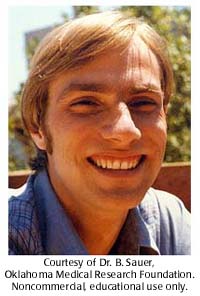மனித மரபுத்தொகுதியைப் புரிந்துக்கொள்ள டிஎன்ஏ ஓர் ஆரம்பம் மட்டுமே!

 Mario Capecchi developed a technique to target and mutate genes in mice using homologous recombination. Brian Sauer adapted the cre/lox recombinase system from phage for mammalian gene knock outs.
Mario Capecchi developed a technique to target and mutate genes in mice using homologous recombination. Brian Sauer adapted the cre/lox recombinase system from phage for mammalian gene knock outs.
Brian Sauer (1949-)

Brian Sauer may be one of the few scientists whose interest in science nearly got him arrested. Sauer (pronounced 'sour') set up his telescope in a dark lot in a nearly deserted housing development to watch Halley's comet. The few houses scattered about looked empty, but one little old lady spotted him and called the state police. Sauer avoided a night in jail after offering the officer a close-up view of the comet.
Growing up on his family's dairy farm north of Madison, Wisconsin, Sauer's first scientific interest was astronomy. He constructed his first telescope from a cardboard tube and fitted it with four lenses. "I grew up in the country, and the sky was always dark," he said. "In school, I told people I was going to be an astrophysicist."
For his first five years of school, Sauer attended a one-room schoolhouse with children in grades one through eight. Around December, he remembers, "there was always a school play and there would be no more classes because the teacher was too busy teaching everyone their parts." To kill time between rehearsals, Sauer played poker with the older students.
Along with the telescope, Sauer also built a short-wave radio and listened to Canadian stations. "But when you're living in Wisconsin, that's not much of a challenge," he confessed. Upping his range, he also managed to pull in European stations and listened to the shows they beamed to the U.S. in English. The experience led him to write a school essay on the propaganda the Nazis broadcasted to the Allied troops during World War II.
During recess at school, Sauer would join the other boys for a game of baseball. (Before astrophysics, Sauer wanted to be a Major League pitcher and he still thinks ex-Milwaukee Brave Warren Spahn was one of the best ever). Their baseball field bordered a swift-running creek, so left-field foul balls would land in the water. Since they only had one ball to play with, Sauer and his teammates would yell "Creek ball!," and everyone had to run to the creek to fish the ball out. "We had to get it before it flowed under the overpass," Sauer says, "because if it flowed past that, it was gone forever."
After high school, Sauer began studying physics at the University of Wisconsin in 1967 but found it tedious and switched to mathematics. One day during his senior year while he was working on a math problem on the big blackboard in his living room, his roommate came in and started sketching the structure of DNA. Intrigued by the molecule, Sauer went to work in a lab in Madison after graduating with a mathematics degree.
"I was a mathematician who was interested in doing some biology, and the most interesting thing about biology, according to my view, was genetics," Sauer recalls. With that in mind, Sauer started graduate school at the University of California, Berkeley in 1973. He worked on the P2 phage, what he calls the "other" phage, since most virologists worked on lambda at the time. When Sauer traveled to conferences to give talks, only ten or so hungover scientists would hear his presentation, because the session on the "other" phage was always scheduled for Sunday morning.
Following a post-doc at Stanford University and a position at the National Cancer Institute, Sauer followed his NCI boss to DuPont in 1984. His colleagues had worked out the biochemistry of the cre/lox recombinase system in the P1 phage, and because the biochemistry was simple, he thought it would also work in eukaryotic cells. Sauer picked the brains of the yeast experts next door and inserted the system into the fungus, expecting sluggish recombination. Instead, "it turned out that the cre worked very efficiently," Sauer says. After the system also worked in mouse cells, he realized "now we could do things [in mammalian cells] that had been done in Drosophila 50 years before."
In 1998, Sauer moved to the Oklahoma Medical Research Foundation where he ran the Developmental Biology Research Program and the mouse knock-out facility. He was then Director of Transgenic Technologies at the Stowers Institute, before moving into genetic engineering consultancy. His research tries to untangle the mechanism of DNA recombination with the ultimate goal of applying this knowledge to more precise redesign of the mouse genome.


Mario Capecchi is said to be a glutton for work. He would often work a full day without a break harvesting and injecting embryos.

When transformed ES cells are injected into blastocysts, they are incorporated into the developing embryo. How?
 டி.என்.ஏ. குரோமோசோம்களுக்குளிருக்கும்
டி.என்.ஏ. குரோமோசோம்களுக்குளிருக்கும் உயர்ந்த செல்கள் ஒரு பண்டைய குரோமோசோம்களை ஒருங்கிணைக்கும்.
உயர்ந்த செல்கள் ஒரு பண்டைய குரோமோசோம்களை ஒருங்கிணைக்கும். சில டிஎன்ஏ'கள் புரதத்தைச் குறியிடாது.
சில டிஎன்ஏ'கள் புரதத்தைச் குறியிடாது. சில டிஎன்ஏ'கள் தாவும்.
சில டிஎன்ஏ'கள் தாவும். மரபணுக்களைச் செயல்படுத்தவும், செயலிழக்கவும் செய்ய முடியும் .
மரபணுக்களைச் செயல்படுத்தவும், செயலிழக்கவும் செய்ய முடியும் . மரபணுக்கள் இனங்களுக்கிடையே நகர்த்தமுடியும்.
மரபணுக்கள் இனங்களுக்கிடையே நகர்த்தமுடியும். டிஎன்ஏ செல்கள் வெளியிலிருந்து வரும் சிக்னல்களுக்கு செயல்படும்.
டிஎன்ஏ செல்கள் வெளியிலிருந்து வரும் சிக்னல்களுக்கு செயல்படும். பல்வேறு செல் வகைகளில் வெவ்வேறு மரபணுக்கள் செயல்பட்டிருக்கும் .
பல்வேறு செல் வகைகளில் வெவ்வேறு மரபணுக்கள் செயல்பட்டிருக்கும் . முதன்மை மரபணுக்கள் அடிப்படை உடல் திட்டங்களைக் கட்டுப்படுத்தும்.
முதன்மை மரபணுக்கள் அடிப்படை உடல் திட்டங்களைக் கட்டுப்படுத்தும். மேம்பாடு, செல்களின் வளர்ச்சி மற்றும் மரணத்தைச் சமப்படுத்தும்.
மேம்பாடு, செல்களின் வளர்ச்சி மற்றும் மரணத்தைச் சமப்படுத்தும். மரபணுக்களின் ஓர் தொகுப்பே ஒரு மரபுத்தொகுதியாகும்.
மரபணுக்களின் ஓர் தொகுப்பே ஒரு மரபுத்தொகுதியாகும். உயிரினங்கள் பொதுவான மரபணுக்களைப் பகிர்ந்து கொள்ளும்.
உயிரினங்கள் பொதுவான மரபணுக்களைப் பகிர்ந்து கொள்ளும். மனித மரபுத்தொகுதியைப் புரிந்துக்கொள்ள டிஎன்ஏ ஓர் ஆரம்பம் மட்டுமே!
மனித மரபுத்தொகுதியைப் புரிந்துக்கொள்ள டிஎன்ஏ ஓர் ஆரம்பம் மட்டுமே!